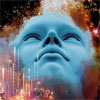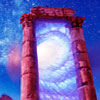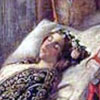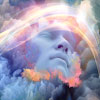Lucid Dreaming
 by Rosemary Ann Guiley
by Rosemary Ann Guiley
Dreaming is usually a passive activity. Dreams happen automatically. The dreamer does not cause a dream to happen and does not control it. Lucid dreaming is different: It is the awareness that one is dreaming while the dream is occurring, sometimes combined with the ability to control the dream. Lucid dreams are the virtual reality of all dreams, a landscape where the strange is real and the real is strange.
Lucid dreaming has been recognized since ancient times. There are different levels of lucidity, from a simple awareness of being in a dream to completely controlling the events and outcome of a dream. Some people have a lucid dream every now and then, and others have lucid dreams almost nightly.
In ancient times lucid dreams were valued because they could be used in magic, or as direct ways to reach the gods. Healing dreams incubated at the great dream temples were often lucid. In modern times lucid dreams are believed to be an advanced dreaming skill that people can learn for the purposes of creativity and healing.
Lucid dreams overlap with astral travel dreams and also psychic dreams. A lucid dream may feel like an out-of-body trip or may look into the future. People usually enjoy lucid dreaming because they experience a sense of great freedom and power.
History
The term “lucid dream” did not come into being until the turn of the twentieth century. The term was created by Frederik Willem van Eeden, a Dutch psychiatrist. Prior to that, lucid dreams were known by their unusual characteristics or were simply called dreams.
The earliest known written account of lucid dreaming in Western history is contained in a letter written in 415 by St. Augustine, a pagan who was converted to Christianity and became one of the most important fathers of the early Christian church. In the letter Augustine described the lucid dream of a physician, Gennadius, who lived in Carthage. Gennadius had two dreams in which a spirit guide in the guise of a young man took him to a beautiful city and lectured him about the truth of life after death.
Lucid dreams, as well as dreams in general, lost their importance in the development of Christianity. Instead, they found their place in occultism and alchemy. Lucid dreaming is important in Islamic mysticism and in the complex dream traditions of Buddhism and Hinduism. Tibetan Buddhism has a sophisticated dream yoga in which the yogi learns to have lucid dreams at will in order to understand the illusions of both waking and dreaming states.
When psychology and psychical research emerged in the late nineteenth century, dreams and lucid dreams became the subjects of study. The Marquis d’Hervey de Saint-Denys, a French professor of Chinese literature and language, documented more than two decades of experiments he conducted in learning how to control his dreams. Sigmund Freud acknowledged the existence of lucid dreams but had little to say about them. Carl G. Jung not only acknowledged lucid dreams, he had many of them himself. For Jung, dreams were an important tool for exploring the psyche.
The fields of parapsychology (the modern term for psychical research) and psychology brought renewed attention to all kinds of dreaming. Modern scientific interest in lucid dreams was stimulated in the late 1960s, especially by the publication of books such as Lucid Dreaming (1968) by Celia Green, an overview of the history of lucid dreams. For the most part the scientific establishment has been skeptical about lucid dreams, believing them to be either impossible or else part of occultism. Nonetheless, interest grew in scientific study and testing of lucid dreams.
The state of lucid dreaming was demonstrated in the laboratory in 1970s in independent studies conducted on both sides of the Atlantic. Lucid dreamers were able to give signals with special eye movements during REM stages of sleep, thus demonstrating that they were asleep and aware at the same time.
Lucid dream research is conducted internationally. Stephen LaBerge is one of the leading researchers in the field and is founder of The Lucidity Institute in Palo Alto, California. As a result of studies done by LaBerge and others in the 1970s, many scientists changed their minds about the possibility of lucid dreaming.
Researchers found that lucid dreamers repeatedly could communicate with the outside world by moving their eyes in certain ways while they were in lucid dream states. In all cases the dreamers were in REM stages of sleep when these signals were given. Thus, it was possible for scientists to chart the physiological changes associated with dreaming.
LaBerge’s subjects were measured to show correlations between actions in their lucid dreams and physiological changes in their bodies and in brain wave activity. Dreamers were given tasks to perform, which were then measured during their dreaming sleep. According to LaBerge, lucid dreaming thus opened the way for new approaches to mind–body relationships.
Lucid dream studies have demonstrated that some, but not all, individuals can learn how to cause themselves to dream lucidly or can increase their control over their lucid dreams. Research shows that women who meditate may be more likely to have lucid dreams than men who meditate and that people who are easily hypnotized are more likely to dream lucidly. People who have had near-death experiences (NDEs), which share many characteristics with lucid dreams, also have more lucid dreams than other people.
Slightly more than half of the adult population has at least one lucid dream during life, and about 21 percent have more than one lucid dream each month. LaBerge’s subjects report that with practice, they can increase the number of lucid dreams they experience on a regular basis. Those who experience lucid dreams believe that the skill of lucid dreaming can be applied to creativity, problem solving, relationships, health, and getting rid of nightmares.
There may be other, more mysterious sides to lucid dreams as well. Physicist Fred Alan Wolf has suggested that lucid dreams—and maybe dreams in general—are visits to parallel universes: small holograms within a larger cosmic hologram. Wolf calls the ability to lucid dream “parallel universe awareness.”
Some lucid dreams seem like mystical experiences involving a sense of connection or oneness with the divine. These lucid dreams often feature spiritual figures such as angels, saints, guides, and divine beings. Some modern researchers believe these dreams are signs of the spiritual evolution of humanity. Perhaps their purpose is to gently introduce people to realms in other dimensions.
Characteristics Of Lucid Dreams
How does one know he or she is dreaming while experiencing a dream? The answers are not always obvious. Lucid dreamers experience certain conditions that clue them into real-time dream awareness. Here are ten of them.
Knowing a dream is in progress. The dreamer realizes that he or she is in a dream while it is happening. The realization may come in a false awakening. The dreamer thinks he or she wakes up, while in fact he or she is still dreaming.
The ability to change the course of a dream. Lucidity enables dreamers to control their dreams in different ways. Sometimes dreamers can decide exactly what is going to happen, such as the actions of themselves and other characters in a dream. They can also rewrite dreams they don’t like. Not all lucid dreamers have total control. Sometimes it is possible to alter only a small part of a dream.
The ability to feel physical sensation. Touching objects in a lucid dream feels as real as it does in waking life.
Unusual abilities and actions. Lucid dreamers often feel weightless. They fly, float, and levitate.
A strange “atmosphere.” Lucid dreams have a different “feel” to them. For example, the atmosphere may feel heavy, like being underwater, or else have an electrical quality, like the supercharged air just before a thunderstorm.
Brilliant light. Lucid dreams may be flooded with intense white light, sometimes enough to make dreamers squint or shield their eyes.
Vivid colors. Colors in lucid dreams are exaggerated. They are exceptionally bright, sometimes fluorescent. Some lucid dreamers say the colors are “not of this world.”
Intense emotions. Like colors, emotions are exaggerated and heightened. Lucid dreamers report feelings of euphoria and excitement.
Mental sharpness. Lucid dreamers feel they have increased brainpower and are able to understand complex things and find solutions to problems.
Out-of-body sensations. Strange sounds in the ears, such as ringing, roaring, and buzzing, as well as electrical sensations in the body, are sometimes experienced at the start of lucid dreaming. People who have out-of-body experiences report the same sensations.
While these characteristics appear in many lucid dreams, they do not guarantee a lucid dream. All lucid dreamers must learn over time what signals a lucid dream to them.
How To Have A Lucid Dream
Lucid dreamers experiment to find the best ways to encourage lucid dreaming. Many find that meditation before going to sleep is one of the best techniques. They quiet their minds and concentrate on an intention to have and remember a lucid dream: “I will have a lucid dream tonight and I will remember it when I wake up.” It is necessary to relax one’s body as much as possible and focus on calm breathing. Let go of thoughts about the day.
Another technique is to decide on a symbol that will help awaken one to lucidity whenever it appears in a dream. For example, one might say, “Whenever I see a dove, then I know I am dreaming.” The symbol should be something that will stand out and be noticed.
Some people discover that sleeping in certain positions is helpful; these vary according to individuals. Sleeping on one’s back or on either side is more successful for most than sleeping on the stomach.
Some lucid dreamers experiment with techniques for WILDs, or Wake-Initiated Lucid Dreaming. Some prefer to sleep first, then wake up and focus on having a lucid dream through self-suggestion. Others have more success during the day at times when they feel like taking naps. Discussions and tips for all kinds of lucid dreaming can be found on The Lucidity Institute’s Web site, http://www.lucidity.com.
Ways To Stay Lucid
One of the most difficult aspects of lucid dreaming is staying in the dream. For many dreamers, as soon as they realize they are lucid, the dream ends. Researchers have learned a few methods of retaining lucidity that work for many people.
Focus on something solid. Focus on an object, the ground, or the body. Touch something solid. Hold your hands up in front of you.
Spin around. This is a favorite technique of LaBerge. As he or she spins, the dreamer should say, “The next object I encounter will be in the dream,” and then stop spinning.
Stay calm. It’s exciting to be in a lucid dream, but the heightened emotion may actually be a dream killer. One way to stay calm is to repeat, “This is a dream” or “I am dreaming.”
What To Do In A Lucid Dream
The first thing to do in a lucid dream is direct the action, which will be determined by the dream itself. It is fun to experiment by trying to levitate or fly. With practice, lucid dreamers attempt more complicated tasks. They may ask for a creative idea or a solution to a problem. They may visit specific places and people on earth or travel around in other dimensions. They may seek to be healed of fears, phobias, injuries, and illnesses.
Researchers and lucid dreamers agree that it is important to act responsibly and not do anything in the dream world that would not be proper in the waking world.
Lucid dreaming is one of the most exciting frontiers in dream research. By studying lucid dreams, people may learn more about the reasons for dreams and how dreams work.
Excerpt from Dreams And Astral Travel
Posted in Lucid Dreaming, Other Topics, Out Of Body Experienceswith comments disabled.





